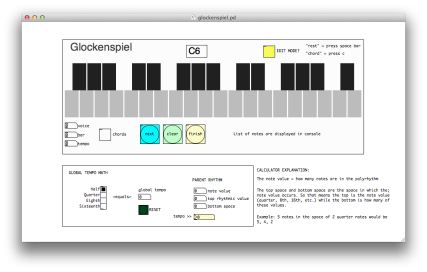Polyrhythms Workshop

As a percussionist, I often get to experience the liberation of polyrhythms because composers know that they can, “give it to percussionists, they’ll figure it out.” This blessing/curse has certainly placed us at the center of a lot of innovative and experimental ideas. One of these has been the advancement of rhythm (which really needed a boost to catch up with advancements in pitch over the past few centuries). In order to handle such complicated rhythms on a regular basis, I’ve developed a few applications using Pure Data that can pedagogically assist the performer.
Admittedly, I used to be opposed to using such assistance because I didn’t think that only using your ear was accurate enough. Therefore, I stuck to graphing everything out…by hand…on paper. (I know, “Very old-timey” you say). On paper, you can visually interpret the spacing of the rhythms rather than aural interpretation. This works very well, although it’s much slower and really only works to a certain degree. Most of Stuart Saunders Smith’s music can be learned this way, but once you start finding embedded rhythms, like a James Dillon or Brian Ferneyhough work, the problem becomes exponentially difficult to work out on paper. This is when I finally gave in and turned to technology.
Unfortunately, this is where standard notation software falls very short (Finale, Sibelius). Yes these applications have given us better ways to load samples, however, over the course of their existence they have failed to fully explore the use of advanced notation – just try to imitate a Crumb or Stockhausen score using one of these softwares and you’ll quickly start looking elsewhere.
The screenshot from the above shows part of an interface in my Pd polyrhythm sequencer patch. It shows the range of a typical glockenspiel and the user would use this as data entry into the application. Right now, I don’t have this patch available online but if you are interested in trying it out feel free to contact me for more details (don’t worry it’s free).
** Credit goes to Rob Esler for first creating a patch for Ferneyhough’s Bone Alphabet. With his help, this gave me the idea to expand it out into other setups and keyboard instruments and in turn, is not limited to seven instruments (like Bone Alphabet).